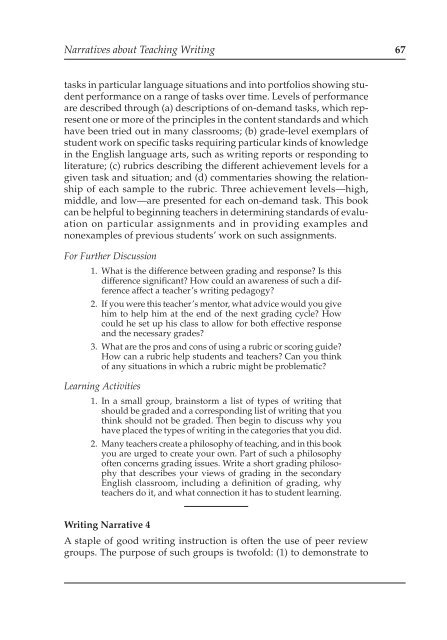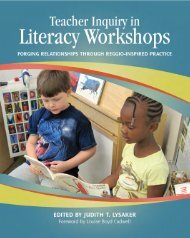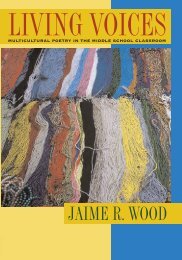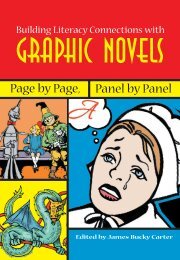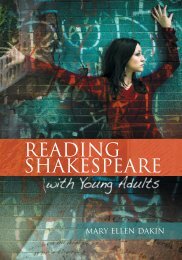2 Narratives about Teaching Writing - National Council of Teachers ...
2 Narratives about Teaching Writing - National Council of Teachers ...
2 Narratives about Teaching Writing - National Council of Teachers ...
- No tags were found...
You also want an ePaper? Increase the reach of your titles
YUMPU automatically turns print PDFs into web optimized ePapers that Google loves.
<strong>Narratives</strong> <strong>about</strong> <strong>Teaching</strong> <strong>Writing</strong> 67tasks in particular language situations and into portfolios showing studentperformance on a range <strong>of</strong> tasks over time. Levels <strong>of</strong> performanceare described through (a) descriptions <strong>of</strong> on-demand tasks, which representone or more <strong>of</strong> the principles in the content standards and whichhave been tried out in many classrooms; (b) grade-level exemplars <strong>of</strong>student work on specific tasks requiring particular kinds <strong>of</strong> knowledgein the English language arts, such as writing reports or responding toliterature; (c) rubrics describing the different achievement levels for agiven task and situation; and (d) commentaries showing the relationship<strong>of</strong> each sample to the rubric. Three achievement levels—high,middle, and low—are presented for each on-demand task. This bookcan be helpful to beginning teachers in determining standards <strong>of</strong> evaluationon particular assignments and in providing examples andnonexamples <strong>of</strong> previous students’ work on such assignments.For Further Discussion1. What is the difference between grading and response? Is thisdifference significant? How could an awareness <strong>of</strong> such a differenceaffect a teacher’s writing pedagogy?2. If you were this teacher’s mentor, what advice would you givehim to help him at the end <strong>of</strong> the next grading cycle? Howcould he set up his class to allow for both effective responseand the necessary grades?3. What are the pros and cons <strong>of</strong> using a rubric or scoring guide?How can a rubric help students and teachers? Can you think<strong>of</strong> any situations in which a rubric might be problematic?Learning Activities1. In a small group, brainstorm a list <strong>of</strong> types <strong>of</strong> writing thatshould be graded and a corresponding list <strong>of</strong> writing that youthink should not be graded. Then begin to discuss why youhave placed the types <strong>of</strong> writing in the categories that you did.2. Many teachers create a philosophy <strong>of</strong> teaching, and in this bookyou are urged to create your own. Part <strong>of</strong> such a philosophy<strong>of</strong>ten concerns grading issues. Write a short grading philosophythat describes your views <strong>of</strong> grading in the secondaryEnglish classroom, including a definition <strong>of</strong> grading, whyteachers do it, and what connection it has to student learning.<strong>Writing</strong> Narrative 4A staple <strong>of</strong> good writing instruction is <strong>of</strong>ten the use <strong>of</strong> peer reviewgroups. The purpose <strong>of</strong> such groups is tw<strong>of</strong>old: (1) to demonstrate to


